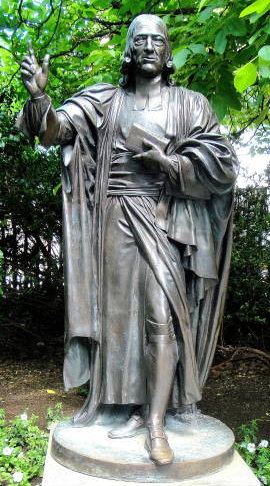Methodist
 ethodism was a religious movement, led by Charles and John Wesley and by George Whitefield, which originated as a reaction against the apathy and the emphasis on logic and reason that characterized the Anglican Church in the early eighteenth century. The term was originally applied to a religious society which was established at Oxford University in 1729 by Whitefield and the Wesley brothers (nicknamed the “Holy Club,” its members were pious young men who, in order to promote piety and morality, observed strict rules of fasting and prayer). Subsequently, it was applied to a variety of evangelical religious groups who took their original inspiration from the movement’s founders, whose views on certain subjects were very different. Whitefield, for example, accepted many traditional Calvinistic views, while the Wesleys tended toward Arminianism and rejected, in particular, the Calvinist doctrine of predestination, insisting that if a man could acquire through the intercession of the Holy Ghost the conviction that Christ loved him and had sacrificed himself for him, his sins would be forgiven. Conservative members of the Church of England in the mid-eighteenth century found the Methodist emphasis on private revelation and religious enthusiasm repugnant, but that same enthusiasm would become a central aspect of nineteenth-century evangelicalism.
ethodism was a religious movement, led by Charles and John Wesley and by George Whitefield, which originated as a reaction against the apathy and the emphasis on logic and reason that characterized the Anglican Church in the early eighteenth century. The term was originally applied to a religious society which was established at Oxford University in 1729 by Whitefield and the Wesley brothers (nicknamed the “Holy Club,” its members were pious young men who, in order to promote piety and morality, observed strict rules of fasting and prayer). Subsequently, it was applied to a variety of evangelical religious groups who took their original inspiration from the movement’s founders, whose views on certain subjects were very different. Whitefield, for example, accepted many traditional Calvinistic views, while the Wesleys tended toward Arminianism and rejected, in particular, the Calvinist doctrine of predestination, insisting that if a man could acquire through the intercession of the Holy Ghost the conviction that Christ loved him and had sacrificed himself for him, his sins would be forgiven. Conservative members of the Church of England in the mid-eighteenth century found the Methodist emphasis on private revelation and religious enthusiasm repugnant, but that same enthusiasm would become a central aspect of nineteenth-century evangelicalism.

John Wesley by Samuel Manning the Younger.
John Wesley, the central figure in the Methodist movement, was a man of considerable intellect and enormous energy. During his lifetime he traveled, mostly on horseback, over a quarter of a million miles, and preached over forty thousand sermons, many in the open air, before audiences which were frequently hostile. He built up an enormous following, however, among the laboring poor of the new industrial areas, whom the established Church of England had tended to neglect, and by the late eighteenth century there were hundreds of Methodist chapels, presided over by itinerant lay preachers. Methodism was very much a religion of the poor, and had a great deal to do with a revolution in English religion which was as radical in its effect, in its way, as was the Industrial Revolution itself.
The social and political impact which the movement exerted upon its main constituency was, however, rather ambiguous. Wesley, who advocated a strict, even brutal, approach to raising children, was politically and socially conservative, and many Wesleyan leaders supported child labor and opposed the teaching of writing in Sunday Schools. On the other hand, other Methodists were much more openly democratic and concerned with working-class issues, taking an active role in the development of trade unions and in radical political activities. The movement remained officially within the Church of England, on however precarious a basis, until after John Wesley’s death in 1791, after which it splintered into a number of factions of various sizes which were not reintegrated until the united Methodist Church of Great Britain was established in 1932.
